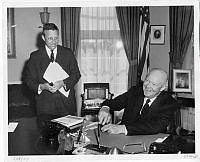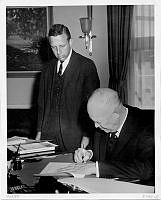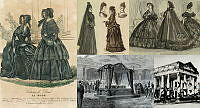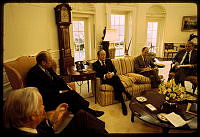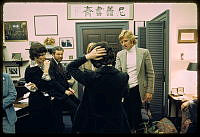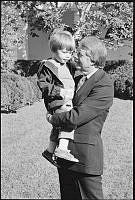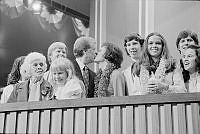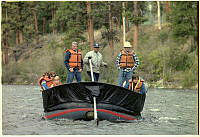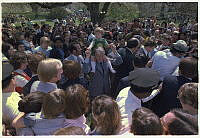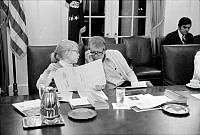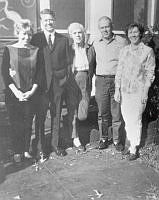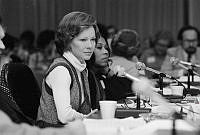Rubenstein Center Scholarship
James K. Polk: The Mexican-American War and the Daguerreian Era
The presidency of James Knox Polk is underscored, among other things, by the War with Mexico. Amidst a military confrontation along the Rio Grande, Congress overwhelmingly declared war on Mexico on May 13, 1846 – the first major conflict for the United States in nearly three decades.1 Shortly after, President Polk and several members of his cabinet sat before daguerreotypist John Plumbe in the State Dining Room of the White House.2 Although photography was still in its infancy, Plumbe’s image captured the personalities of Polk’s cabinet and provided visual insight into the Executive Mansion during the 1840s.
Plumbe first established a studio in Washington, D.C., in 1845. His daguerreotypes of public buildings gained considerable recognition, resulting in the gradual expansion of his businesses into 25 galleries across the eastern seaboard.3 The art form had developed considerably since the inception of the daguerreotype in 1839 by French printmaker Louis Daguerre; and grew into the first commercially successful photographic process.4 The phenomenon of “daguerreotypemania” quickly spread throughout Europe and eventually reached the United States by the time Polk and his cabinet sat for Plumbe’s famed image.5
Plumbe was christened the “American Daguerre” by the press for his poignant works.6 Under the heading, “Perfection of Miniature Taking,” The Brooklyn Daily Eagle declared “there are some ‘heads’ in Plumbe’s Daguerreotype gallery in Broadway, N.Y., that strike us as being superior to any pictorial representations of the human face we ever previously saw.”7

Plumbe daguerreotype of the Polk White House, presumably taken in early 1846. Note the patch of melting snow on the lawn and the barren tree branches that flank the White House.
Library of CongressThese advancements in photography led to opportunities to visually capture moments and figures of the mid-19th century White House. The work of John Plumbe offers a brief glimpse inside the Executive Mansion before the late 19th and 20th century renovations and redecorations. Plumbe photographed a remarkably detailed and clear representation of the South Front, presumably in January 1846, making it the earliest known photograph of the White House exterior.8
While Plumbe specialized in capturing the grandeur of public buildings, the Welsh daguerreotypist photographed President Polk and his cabinet at a pivotal moment of the Polk presidency.9
This image of Polk’s cabinet, taken sometime in May or June 1846, depicts an upright and proper President Polk sitting in the middle with his thumb hooked on his waistcoat. To the right of the president is Secretary of the Treasury Robert J. Walker. Beside the president on the left is Secretary of War William L. Marcy, and rounding out the front row is Attorney General John Y. Mason on the far left. In the back row, Postmaster General Cave Johnson stands in the middle. Secretary of the Navy and historian George Bancroft, whose white vest and pants emerge unique from his pictured compatriots, stands in the back right.
Historian William Seale claims that First Lady Sarah Polk requested Plumbe’s presence after a cabinet breakfast one morning in an effort to coax the Attorney General into sitting for the picture. Mason ardently refused, yet Mrs. Polk persisted in her request. Though Mason eventually agreed to the photograph, his slouched stature and brash smirk suggest his irritation with the matter. While each of the other seated men posed with both hands visible, Mason draped his left arm behind the chair in stark contrast to the more formal style of President Polk and the rest of his cabinet.10

Plumbe’s famed image with which he documented President James K. Polk’s 1846 cabinet around the time of the United States’ declaration of war on Mexico. Seated, left to right: Attorney General John Y. Mason, Secretary of War William Marcy, President Polk, Secretary of the Treasury Robert J. Walker; standing: Postmaster General Cave Johnson (center); Secretary of the navy George Bancroft.
James K. Polk MemorialAdditional symbols in the daguerreotype possibly imply the opinions of other members of Polk’s cabinet. When President Polk heard of the growing tensions between Mexican and American military forces, Bancroft was the only member of the Polk cabinet who admonished the president’s policy. Outnumbered, Bancroft begrudgingly went along with the declaration of war.11 Bancroft’s face reveals a different expression of vexation compared to Yates. Bancroft had admonished the president’s expansionist policy in Mexico, only to find himself alone in his position. While he begrudgingly went along with the declaration, Bancroft did not last long in Polk’s cabinet, resigning in protest that September.
Aside from the people depicted in the image, the photograph’s setting is also historically significant. It is the earliest known interior photograph of the White House.12
Behind the seated figure of Marcy, one of the Italian marble mantels ordered by James Monroe can be seen. In the reflection of the mirror dangles one of the glass-beaded chandeliers he had installed in the room as well. Visibility of a pattern on the wallpaper is marginal due to the dimness of the image, while the carpet is florally decorated. The side chairs the four men rest on were constructed specifically for the State Dining Room in 1845 by New York cabinetmaker Charles A. Baudouine.13 The chair of Robert J. Walker, seated furthest right, provides the most insight. The velvet purple upholstery is exposed beneath his left leg, and the natural light gleams off the intricate carvings in the rosewood cabriole of the furnishing.14 White House dinner guest Elizabeth Dixon described the Polk-era State Dining Room as such: “Three long windows were hung with purple & gold coloured figured curtains, & purple velvet chairs with carved rose wood frames, as the furniture is all new & fresh & all the decorations newly gilded, it was very splendid.”15
John Plumbe’s daguerreotypes therefore served a multi-faceted purpose in history. First, the images remain treasured and useful sources of the Polk-era White House. Plumbe’s renderings also captured a story of acrimony and admonishment within the Polk cabinet after the declaration of war on Mexico. Moreover, the photographs acknowledge a unique way in which the Executive Mansion was brought to life through visual interpretation.

Forty-two of these rosewood chairs adorned the newly redecorated State Dining Room in 1845. The Polk’s installed matching purple-and-gold draperies soon thereafter.
White House Historical Association







